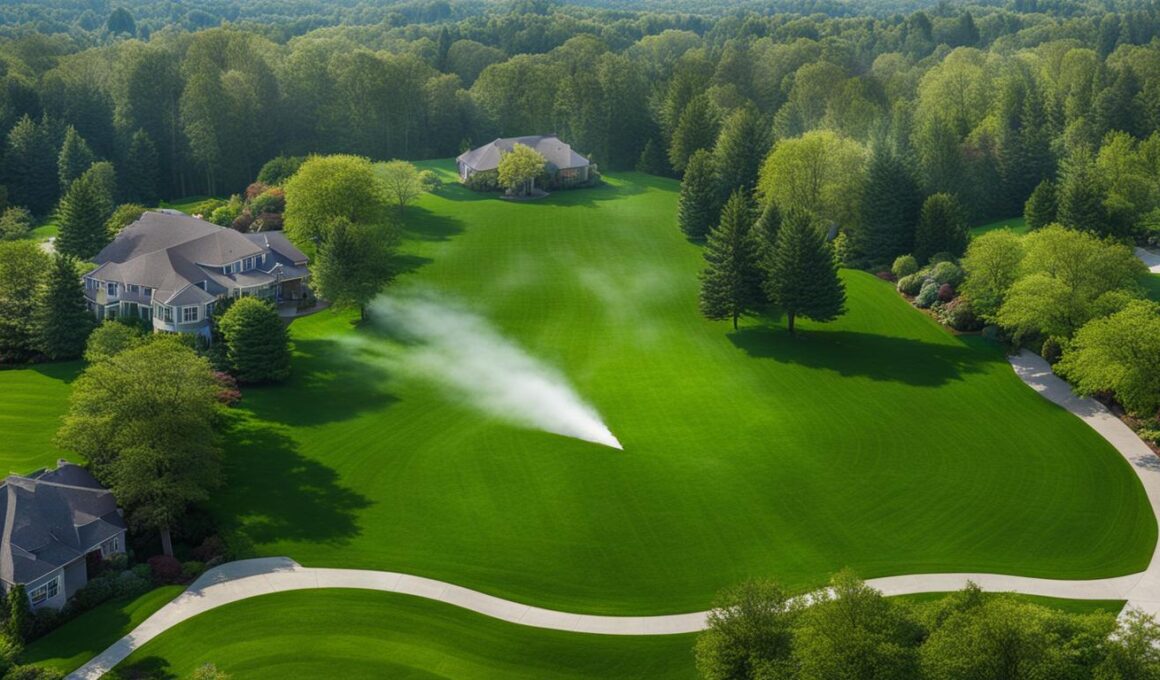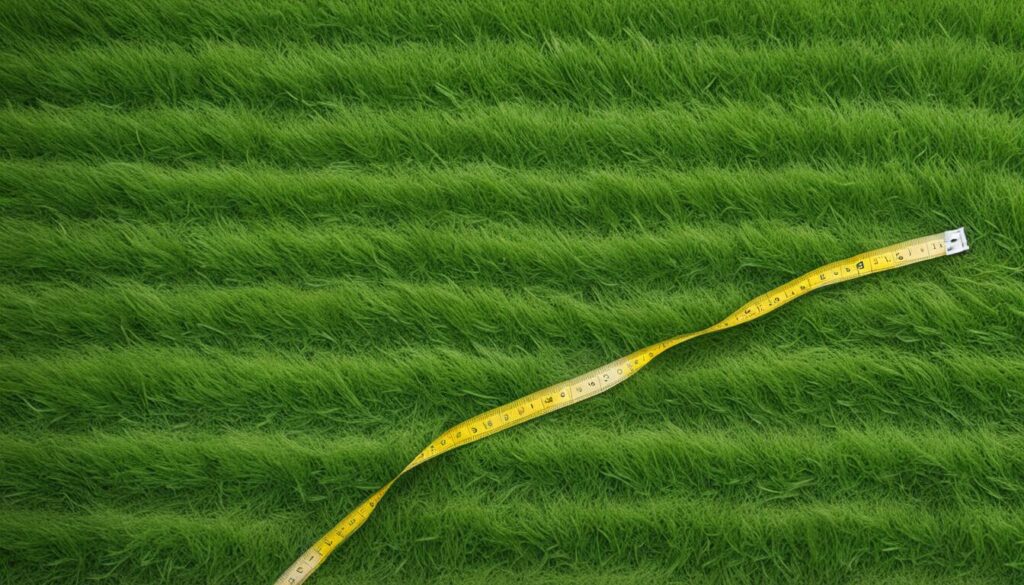Transform your lawn effortlessly with our innovative spray grass seed solution. If you’re looking to start fresh and achieve a lush, green yard, now is the perfect time to give your lawn a complete makeover. With careful planning and the right steps, you can easily rejuvenate your lawn and create a vibrant outdoor space to enjoy.
Key Takeaways:
- Give your lawn a complete makeover by using spray grass seed.
- Achieve a lush, green yard with careful planning and the right steps.
- Rejuvenate your lawn and create a vibrant outdoor space to enjoy.
- Start fresh by measuring your lawn accurately and choosing the right grass seed.
- Kill the existing lawn and improve the soil to prepare for the new seed.
Measuring the Lawn and Choosing the Right Grass Seed
The first step in a lawn makeover is to measure the dimensions of your lawn accurately. This will help you calculate the amount of grass seed and fertilizer you’ll need. Take the time to walk the perimeter of your lawn and count your steps to determine the length and width. Multiply these measurements to get the total area.
Once you have measured the lawn, it’s time to choose the right grass seed for your desired results. Consider factors such as sunlight exposure, climate, and traffic to select a seed variety that will thrive in your lawn. Whether you want a lush, green lawn or one that’s more drought-tolerant, there are specific grass seed options available to suit your needs.
For smaller lawns, you may find it easier to use a handheld or push spreader to distribute the grass seed evenly. If you have a larger lawn, a walk-behind spreader or a broadcast spreader will help you cover the area more efficiently. Regardless of the method you choose, make sure to follow the recommended seeding rates for the specific grass seed you’ve selected.
Choosing the right grass seed and accurately measuring your lawn are crucial steps to ensure successful overseeding and a healthy, vibrant lawn. So take the time to gather the necessary measurements and carefully select the appropriate grass seed for your lawn makeover project.
Killing the Lawn and Improving the Soil
To achieve a fresh start for your lawn makeover, it’s essential to kill the existing lawn and improve the soil. This ensures a clean slate for the new grass to thrive and promotes healthy growth. Follow these steps to properly kill the lawn and enhance the soil before moving forward with the restoration process.
Kill the Lawn
To effectively kill the lawn, you’ll need to use a non-selective herbicide like Eraser. This powerful solution targets the entire lawn and weeds, eliminating any unwanted vegetation. It’s crucial to carefully follow the manufacturer’s instructions to ensure safe and effective application. One important precaution is to avoid overspraying onto desirable plants to prevent damage. Applying the herbicide evenly over the entire lawn will ensure thorough coverage.
Allow Time for the Herbicide to Work
After spraying the herbicide, allow it to work its magic for 7 to 10 days. During this time, the herbicide will penetrate the grass and weeds, killing them at the root. Be patient and resist the temptation to rush the process. This waiting period is crucial for successful lawn restoration.
Spot-Spray Remaining Green Areas
Once the initial herbicide has had time to work, inspect your lawn for any remaining green areas. These may include stubborn weeds or patches of surviving grass. Spot-spray these areas with the herbicide to ensure complete eradication. Be meticulous in this step to prevent any potential re-growth after the restoration process.
Soil Improvement for Optimal Growth
Enhancing the underlying soil is vital for the new grass to thrive. Begin by removing any debris, rocks, or large clumps of dead grass from the surface. This will create a smooth and uniform area for the new lawn to take root. Consider aerating the soil to improve air circulation and water absorption, creating a conducive environment for healthy grass growth.
Additionally, amending the soil with organic matter such as compost or peat moss can provide essential nutrients and improve soil structure. Spread a thin layer of the chosen organic matter evenly over the soil, then use a rake to work it into the top few inches. This process encourages microbial activity and enhances nutrient availability, leading to healthier and more vigorous grass.
By killing the lawn and improving the soil, you are setting the stage for successful lawn restoration. The next step involves seeding and maintaining the new lawn for optimal results. Stay tuned to learn how to achieve a luscious and vibrant lawn that will enhance the beauty of your outdoor space.
Seeding and Maintaining the New Lawn
Now it’s time to seed the new lawn. To get started, choose your preferred Grass Pad seed that is suitable for your region and the specific needs of your lawn. Spread the grass seed evenly over the prepared soil using a spreader or by hand casting. Ensure complete coverage, paying extra attention to bare spots or areas with thin grass coverage.
Overseeding is a crucial step in achieving a lush and dense lawn. If you notice any thin or patchy areas, apply additional grass seed as needed. This will promote uniform growth and help fill in any bare areas, giving your lawn a more consistent and lush appearance.
To protect the newly seeded areas and improve moisture retention, it’s recommended to cover the seeded areas with a light top dressing. You can use weed-free conditioner or sphagnum peat as a top dressing. This will help prevent the grass seed from being displaced by wind or rain while providing the necessary nutrients for germination and growth.
Pro Tip:
Watering is a crucial aspect of lawn maintenance during the germination phase. Keep the seeded areas consistently moist, but avoid overwatering, as it can wash away the grass seed. Follow the watering instructions provided by the grass seed manufacturer to ensure proper establishment and healthy growth.
Remember, the success of your new lawn depends on regular maintenance. After the grass germinates, it’s important to follow a lawn care routine that includes mowing, watering, and fertilizing. With proper nutrients and care, your new lawn will thrive and provide a beautiful outdoor space for you and your family to enjoy for years to come.
Conclusion
Congratulations on successfully renovating your lawn and achieving a stunning green yard transformation using spray grass seed! By following the step-by-step process outlined in this article, you can create a lush and vibrant outdoor space that will be the envy of your neighbors.
To begin your lawn renovation, start by selecting the right type of grass seed that suits your climate and soil conditions. This will ensure optimal growth and long-term success. Once you have chosen the seed, it’s time to kill off the existing lawn using a non-selective herbicide. This step is crucial to provide a clean slate for your lawn makeover.
Next, focus on improving the soil quality to create a favorable environment for your new grass to thrive. This may involve adding organic matter, such as compost or peat moss, to enrich the soil and enhance its nutrient content. Remember, healthy soil leads to healthy grass.
After the preparation work is complete, it’s time to sow the grass seed evenly across the prepared soil. Make sure to follow the recommended seeding rate and pay extra attention to any bare spots. Lightly cover the seeded areas with a top dressing to protect the seeds and promote moisture retention during the germination process.
Lastly, maintain your newly renovated lawn by practicing proper lawn care techniques. Regularly water, mow, and fertilize your lawn to keep it looking lush and vibrant. Remember, consistency is key in maintaining a beautiful green yard.
With the right approach to lawn renovation, spray grass seed, and ongoing maintenance, you can enjoy a stunning transformation of your outdoor space. Sit back, relax, and take pride in your revitalized lawn.
Is Spray Grass Seed a Good Option for Planting Micro Clover in my Lawn Makeover?
Spray grass seed may indeed be a good option for incorporating micro clover in your lawn makeover. This ecofriendly grass alternative not only enhances the overall aesthetics but also provides numerous benefits. Micro clover is hardy, low-maintenance, and fixes nitrogen in the soil, reducing the need for fertilizers. Its integration through spray grass seed can transform your lawn into a lush and sustainable green space.
FAQ
How do I measure the dimensions of my lawn accurately?
To measure your lawn accurately, walk the perimeter and count your steps to determine the length and width. Multiply these measurements to get the total area.
What type of herbicide should I use to kill the existing lawn?
Use a non-selective herbicide, such as Eraser, to spray the entire lawn and weeds. Follow the manufacturer’s instructions and avoid overspraying onto desirable plants. Allow the herbicide to work for 7 to 10 days before spot-spraying any remaining green areas.
How do I seed the new lawn?
Choose your preferred Grass Pad seed and spread it evenly over the prepared soil. Pay extra attention to bare spots and apply additional seed as needed. Cover the seeded areas with a light top dressing of weed-free conditioner or sphagnum peat to improve moisture retention and protect the seed.
How do I maintain the new lawn?
Proper lawn maintenance includes regular watering, mowing, and fertilizing. Water the new lawn deeply and infrequently to encourage deep root growth. Mow regularly, keeping the grass at an optimal height for your chosen grass type. Apply fertilizer according to the recommended schedule for your specific grass seed.
How long does it take for a new lawn to establish?
Depending on the grass seed variety and environmental conditions, a new lawn can take anywhere from a few weeks to several months to establish. Consistent maintenance and proper care will help speed up the establishment process.











